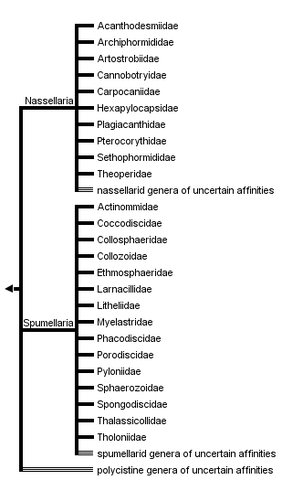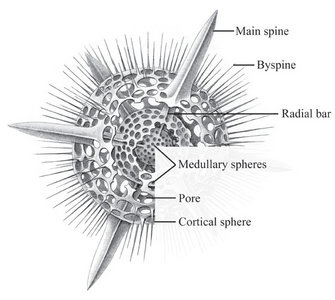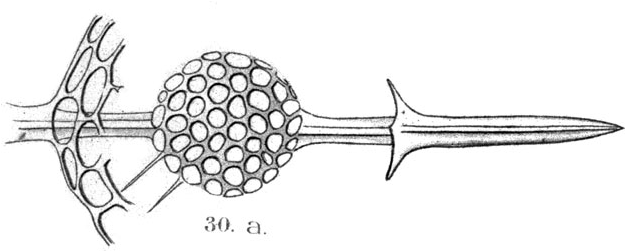 Phylogenetic tree (3)
Phylogenetic tree (3)
Description:
- Member of Rhizaria, characterized by by the presence of needle-like pseudopodia (1)
- Member of Radiolaria: holoplanktonic protozoa and form part of the zooplankton, they are non-motile (except when flagella-bearing reproductive swarmers are produced) but contain buoyancy enhancing structures; they may be solitary or colonial (2)
- Marine planktonic unicellular eukaryotes(3)
- Possesses a central capsule (used to distinguish radiolarians from other protists) (4)
- More commonly known for their siliceous skeleton (test) (4)
- Characterized by its fairly delicate and thin third cortical shell, with regular to irregular rounded pores (6)
- There are only seldom needle shaped byspines on the third shell, when present they are not as numerous nor as well developed as in the other species of this genus (6)
Habitat(6):
- Only found in deep water, especially at a depth of 300m or more
- More frequent on the west coast of Norway
- Also known from scattered spots in the sea beyond the coast of Norway and from the Faeroe and Shetland Isles northwards
Nutrition(4):
- Capture and digest a large variety of small preys (e.g. silicoflagellates, ciliates, tintinnids, diatoms, crustacean larvae, copepods and bacteria)
- Use “sticky” pseudopodia to catch prey
- Several different feeding strategies have been reported for radiolarians
- The captured food is enclosed in a digestive vacuole and carried into the ectoplasm where the digestion occurs
Reproduction(4):
- Knowledge on radiolarian reproduction is very limited
- Both asexual and sexual reproductions have been proposed
- Dimorphic, sexual-asexual, alternating generations analogous to the reproduction stages of foraminifera has been suggested
- Reproduction processes observed so far are: 1) binary fission and 2) multiple fission
Interesting facts(3):
- Have beautiful shapes that have interested scientists, painters, jewelers, quilters, sculpturers, musicians and architects alike


